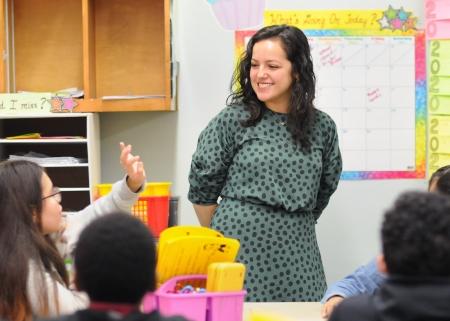
Middle school math teacher Jennifer Privitera has found a way to help her students develop discussions.
When I became a middle school math teacher 12 years ago, one of the first things I noticed was how chatty students can be. So I was surprised when, after I asked my students to discuss a math problem, strategy or solution with their group members, the room would suddenly get quieter.
It wasn’t long before I realized that while students do love to talk, they simply have never been taught how to have an academic discussion — especially in math class. It became clear that there needed to be protocols in place to foster awesome math discussions that enhance student learning.
First and foremost, I am very intentional about how I group students. I assemble heterogeneous leveled groups so there is a mixture of abilities, learning styles and perspectives that contribute to richer discussions.
Since groups change frequently depending on the topic we are learning, I like to give students an icebreaker activity to get each student comfortable enough with their group members to be ready and willing to contribute to group discussions.
Once we’ve formed groups and finished a lesson, students will have the content vocabulary necessary to know what to discuss, but we then have to make sure they know how to speak to each other in kind, supportive, collaborative ways.
For this, I rely on accountable-talk stems such as “I agree (or disagree) because …,” “I noticed that …,” “I like the way you … because …,” “Another method or strategy might be …,” “I am confused by …,” “This connects to what we learned about …,” etc. These stems allow students to formulate their thoughts into coherent discussion points and respond to their classmates’ comments.
I also learned that I have to be clear in the protocols I provide to students so they know which group member should begin the discussion, what role each group member has in the discussion and how long they should be discussing the prompt. For example, let’s say I want students to discuss their preferred strategy for finding the percent of a number. I might give students two minutes to write their response silently. Then I designate which member in each group begins the discussion by sharing what they wrote and allow group members to respond using their accountable-talk stems. The discussion proceeds for a set time until all group members have shared. All students get the same amount of time to speak and the chance to hear peer feedback.
You might be wondering what happens if a student in the group is confused about the topic or is unsure how to answer a question, which could lead to a hesitance to participate. That’s why it’s important to create a positive, risk-free environment that allows students to see mistakes and misconceptions as moments for learning as opposed to occasions for judgment. I also teach my students the importance of coaching each other through their confusion by teaching instead of telling.
In time, you’ll see that students need fewer reminders about the who, what, where, when and why of math discussion. They’ll be engaging in richer discourse that leads to increased understanding.
Jennifer A. Privitera is a math teacher at IS 45 in the Bronx and a New York State finalist for the Presidential Award for Excellence in Mathematics and Science Teaching.